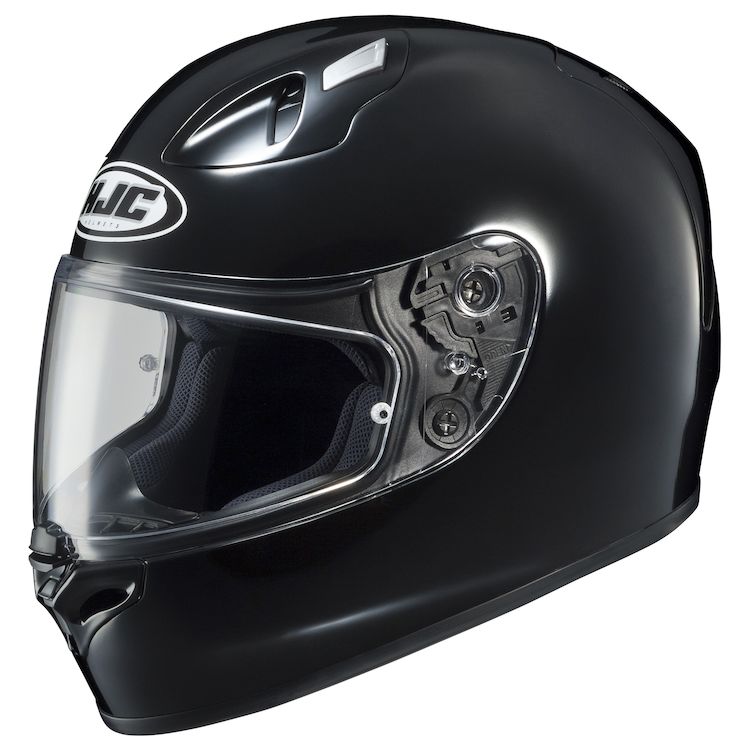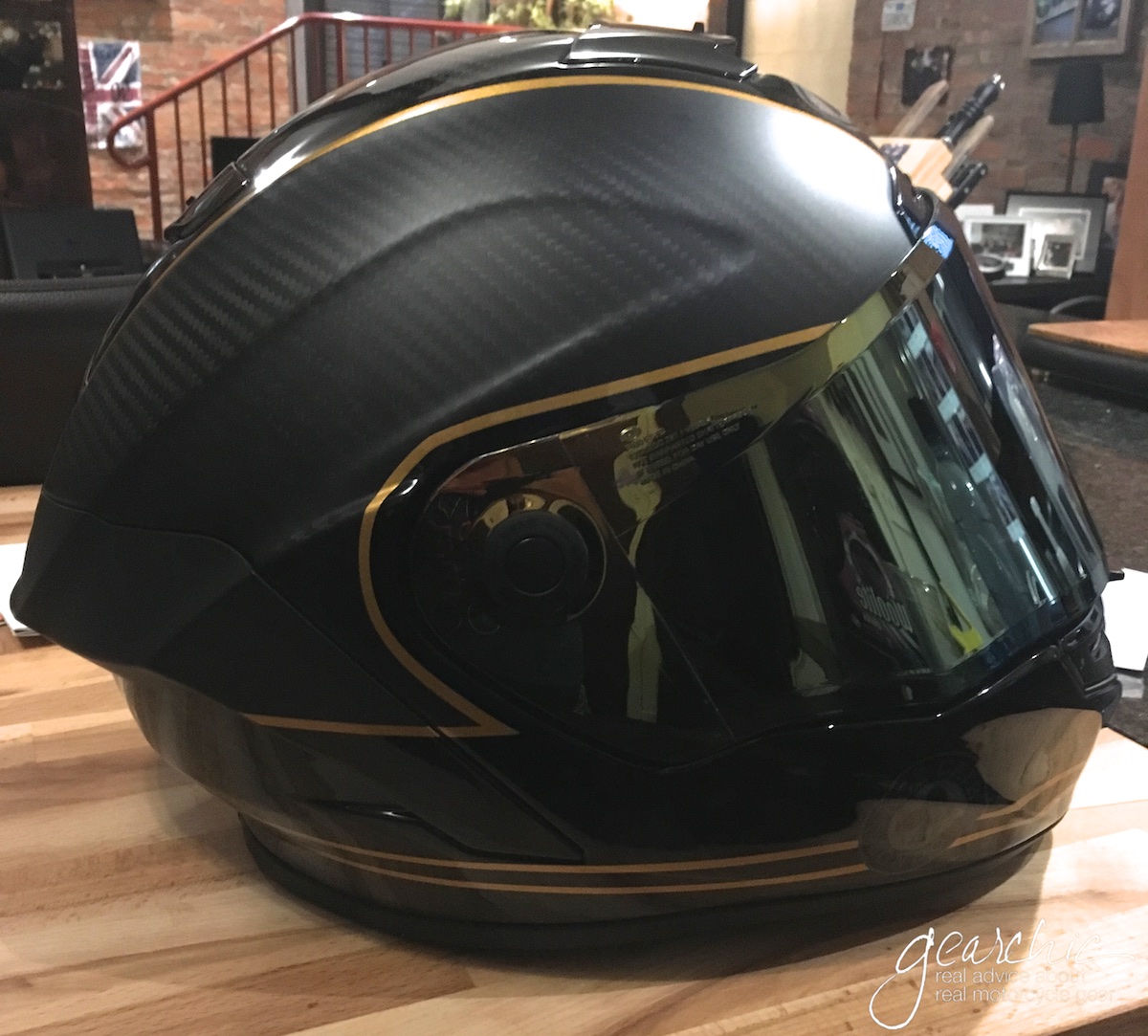Me wearing my Shoei RF-1200 along Skyline Drive in VA
If you're on this page, then I have to assume that you're thinking about a full face helmet and you need some information to help you shop for one. YAY! I’m so happy for you.
I'm not going to tell you to wear one because you already know this, instead I’m here to tell you how you should wear one and some things to look for. There are plenty of resources on the interwebs which will tell you that wearing a full face helmet will save your brain. But how do you pick one? And how do you decide whether or not it fits right?
What Kind of Helmet Should I Get?
The short answer is this: the one that fits you the best.
But sometimes it’s challenging to figure this out. Hopefully this particular helmet will also have the best safety standards, including DOT to ride legally in the United States. But also a snazzy Snell or ECE rating too. Chances are, the more expensive it is, it will probably fit you better. I know it's not what you want to hear but those brand spend a LOT of time and money to create not only the highest quality helmets, but the most comfortable ones.
The more you ride, the more you will appreciate a premium helmet. However, this doesn’t mean you absolutely have to purchase the most expensive helmet you can afford.
With a helmet that offers higher pricepoints, typically the way that you will directly benefit (aside from extreme crash testing of course) will be in features and comfort like:
cushy liners, removable and re-sizeable (ex. Shoei RF1400)
quieter, reducing external wind noise (but not silencing it completely)
aerodynamics, less resistance when doing head checks at freeway speeds and less buffeting overall at higher speeds
fit, possibly the most comfortable and best fitting for your head shape, e.g. Long Ovals tend to find the Arai Signet-X to be the only helmet that offers a great fit without sizing up to accommodate a longer fit from front to back. If you’re not sure what that means, click here.
shell sizes; for those of us with XS heads, it’s supremely important for our helmet shells to not share the same shell as a M or L. Premium brands like Shoei/Arai offer four (4) shell sizes, which is usually a more expensive investment. This means the overall profile is smaller and in turn, the weight is reduced as well
weight; premium brands like Shoei/Arai/HJC will offer Fiberglass shells to lighten the helmet even more. Keep in mind that it’s not just how much it weighs overall, but the distribution of weight so the helmet’s center of gravity is low, not high
How Should It Fit?
Generally speaking, you want a snug fit and buy the size knowing that it will get a little looser and break in over time. Here are a few things to consider when you’re shopping:
Never buy a size that fits perfect the day you try it on in the store, it will always break in so you need to assume that it will loosen up as it breaks in
Never buy a helmet based on colors/graphics/designs; every helmet has a different fit/shape UNLESS you are consciously deciding to compromise fit and comfort because you specifically want that graphic / design. Nothing wrong with having many helmets! However, you *must* find a helmet that fits you well so it can save your brain from serious head injury/trauma, not your self image. But also because the more time you spend in your helmet, the more you will notice any issues with fitment and comfort. So if you’re planning a long 2-3 day ride and plan to spend a lot of hours wearing that every day
Always buy a new helmet when you buy a used motorcycle. You don't want his/her used helmet, you need one that fits you, not them.
Know your head's measurement in cm/in and general shape
Never buy a helmet that causes pressure points in one region of your head e.g. forehead. If one spot stands out, it will probably get worse over time.
Fit Tips:
Listen to Episode 9 of my GearChic Podcast for Helmet Fit Tips
Proper helmet fitment is HARD. Really, freaking hard. I’m not going to sugarcoat this. Because figuring out a helmet that fits you perfectly is not easy. I’m 6? helmets in at this point and I still struggle with whether my helmet fits well sometimes.
First, let’s start with the Caveats:
it should all feel (equally, all the way around the crown of your head) uncomfortable until you break it in a bit
it’s going to fit tighter than you think, period
you need more than a few minutes to determine proper fit, be prepared to spend a good 20-30 minutes at home or in the store to really see if you should buy it
without truly understanding your fit, you’ll never make the right decision. So try on that more expensive Arai because chances are, it’ll be the perfect fit.
These are a few tips to help you figure out if you’ve at least landed near the correct size. But if any of the above goes wrong, then that is going to make fitment 10x’s harder! I’m going to provide this list of tips assuming you are wearing the right fit and shape for your head. Because if you’re not, even these tips won’t help you:
Borderline snug to where it makes you think twice about the sizing
Equal, balanced snugness around the crown of your head.
Cheeks should be the tightest fit of the helmet (most brands offer different sizes, so check with yours). These are typically the easiest thing to fix. The harder part is to fix crown/forehead/skull discomforts
Any unbalanced pressure (forehead, temples, back of your head, above the base) AFTER at least 3-5 minutes
So snug that you need just a little bit of break-in (~10-20% depending on the brand)
I always recommend trying on options that might be more expensive, just to see what fits you the best (regardless of price or style) so you can understand “this fits!”. Typically, more expensive helmets are more comfortable and offer the best fit shapes.
And even if you can’t afford that $$$ helmet, you can at least know what it’s supposed to fit like, so you can find the more affordable option that comes almost as close. Often I found that people who would spend literal hours trying to choose a helmet, is because they never established what the right fit was in the first place.
Having that frame of reference is key!
1. SHAPE
I like to think of helmet fits like shoes. You either need a wide shoe, a standard width shoe or a narrow shoe.
There’s a lot of info in this graphic but ignore the numbers. Just focus on the shapes themselves and the description of each. The very first step you have to take is what is the shape of my head? Just like when you are buying a pair of pants. If you’re 6’ tall with a 35” inseam, would you ever try to buy a pair that doesn’t offer you the correct inseam?
The same goes with helmets. The safety, the performance, the noise, everything about the way your helmet will work is totally dependent on getting this right. Unfortunately figuring this out without someone who can really walk you through this process in person is extremely difficult.
2. SIZING
Before you attempt to size, you must understand that size charts ONLY indicate recommended circumference for your head. So if you end up ordering a helmet online with only the size chart and no one to fit you in person, here are a few signs that the helmet is the wrong fit shape for you:
And there are multiple factors that will add to your size issues including:
Me, testing out my helmet fit at home for 20-30 minutes. Always test ride in your living room!
Having a poor frame of reference for helmet fit (e.g. the last time you bought a new helmet it was 1995)
Drastically changing your hairstyle from season to season (going from a full head of hair to no hair, braids, etc.)
Drastically losing weight or gaining weight in your face/neck
Being sized by someone who is NOT trained to do so
Buying a helmet purely because of style/looks
Fitment below the temple line (well below where things are measured) is sometimes subjective
There’s more issues I’m sure, but it’s going to vary on the individual’s riding situation. Proper sizing and fitment go hand in hand and sometimes you won’t know whether to make a compromise in one or the other. It’s usually something you have to get help with in person at your local dealership.
If all else fails, you can always contact me so we can set up a video chat.
3. COMFORT
Okay, so there’s this thing called comfort. I’m on my 6th? 7th? 8th? helmet? At this point, I’m used to a really tight fitting helmet.
I’ve worn big helmets, average fit helmets and now perfectly fitted helmets. At this point I’ve figured out exactly what I like as far as fitment, what does and doesn’t work for my pinhead. For me, comfort is defined by TIGHTNESS. If it isn’t tight at first (imagine The Rock is squeezing your hand for a really strong handshake). The reason I need and want this fit is because when I had a helmet that was too wide (left to right) I found myself getting a hot spot on the Center of my head, right on the top. The reason for this was because the helmet was resting on my head, not fitting it.
Me in my Shoei RF-1200 XS, even though the chart says SM because I’m an intermediate oval and my head is tiny.
Sizing up for comfort is reasonable when you’re in between sizes and can’t decide. You can usually work with a looser helmet (wearing a headcap, etc.) but it’s usually difficult to work with one that’s too tight. You’ll also size up because you’re a round oval but you really love that new Shoei RF-1200 graphic so you size up. Not the end of the world, just not ideal.
Something else to keep in mind is that more comfort should come the more you wear a brand new helmet. It might be your first time, it might be a new brand, or a new fit that you’re not used to (e.g. getting fitted into the right shape after wearing the wrong one for so long).
There are so many other things that might come into play but I can’t predict all of them. I hope these help and if not please drop me a line!
motorcycle helmet faqs
Why is my forehead hurting after ~30 minutes - 1 hour of riding? Because you need a Long Oval, your current helmet is probably too round or intermediate.
Why is my full face helmet so loud? Because you’re either:
not wearing earplugs
your helmet ventilates too much
wearing a dirtbike / dual sport helmet for mainly street riding
your helmet is too big / too loose
wearing a race helmet (Race Star, Corsair-X, X-14, Corsa) for mainly street riding
How do I find a quieter full face helmet? I have a few thoughts here, but here are a few more things to consider:
wear ear plugs
make sure it’s the correct size and fit
make sure you’re not wearing a racing or dirt or adventure style or modular helmet. However, there are several premium modulars (Shoei Neotec 2, HJC Rpha 91, Schuberth C4 Pro) on the market that are quieter than some full face helmets
Why do my ears hurt after 30 minutes - 1 hour of riding?
it’s probably too narrow and you need something a little wider from ear to ear.
Why does my helmet move when I’m going ~60-70mph?
it’s probably too big and it’s not fitting you snug enough all around; sizing down isn’t necessarily the solution, either. You probably need a narrower fitting helmet or tighter cheekpads.
Why can’t I see very well when I’m on my sportbike?
because you’re wearing a touring helmet which has a very low field of vision. The helmet on the left is the HJC FG-17. This is 100% a street helmet and has a very straight field of vision, so as you start to lean aggressively forward, you start to see the top brow of your helmet. As soon as you sit up it goes away. This tells you that the helmet isn’t designed to adjust the view as soon as you start crouching close to the tank.














